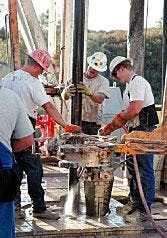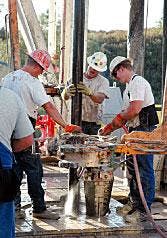Scientists are drilling a 4 km borehole on a cattle ranch near Parkfield, Calif., in an attempt to drill directly to the hypocenter of a zone of recurring microearthquakes in the center of the San Andreas fault zone.
The San Andreas Fault Observatory at Depth (SAFOD) project will cost about $20 million, funded entirely by the National Science Foundation. SAFOD is part of the $200 million, 5 year instrumentation set up for EarthScope (www.earthscope.org), a project focused on North American tectonics.
The SAFOD project has three major stages, run by principal investigators from Stanford University and the US Geological Survey. The project seeks to answer questions about the "physical and chemical processes controlling the initiation, propagation, and arrest of earthquake ruptures within a major plate-bounding fault."
Researchers chose Parkfield, midway between San Francisco and Los Angeles, because the town regularly experiences Magnitude 6 earthquakes and has been dubbed the "earthquake capital of the world."
null
The San Andreas fault runs about 800 miles along the Pacific and North American tectonic plate boundary, from Mexico to northern California. It's a nearly vertical, right-lateral shear fault, with the Pacific plate moving north relative to the North American plate.
Advanced drilling technology
Steve Hickman (USGS earthquake hazards team), one of SAFOD's three principal investigators, said the project is using advanced directional drilling technologies developed for the oil and gas industry.
On June 12, 2002, drillers spudded a vertical pilot hole about 1.8 km southwest of the San Andreas fault. This section of the fault exhibits both aseismic creep and repeated microearthquakes.
The hole was rotary drilled to 7,112 ft using 15 drillbits. Scientists attempted to collect core at the bottom of the hole using a top-drive coring system developed by the nonprofit DOSECC Inc. (Drilling, Observation & Sampling of the Earth's Continental Crust).
The pilot hole was set up for drillbit seismic testing using Schlumberger Ltd.'s DBSeis system (OGJ, May 11, 1998, p. 53). Seismic, strain, and pore-fluid pressure instrumentation was left in the hole. Scientists from Duke University, Virginia Tech, University of Wisconsin, and Rensselaer Polytechnic Institute ran separate geophysical experiments near the pilot hole after drilling was completed.
Latest progress
In the second stage of the project, the main borehole is being drilled slightly offset from the pilot hole. Baker Hughes Inteq is providing directional drilling expertise.
On June 11, drillers spudded the main hole using Nabors Drilling USA LP's Rig 633. The rig is rated to 25,000 ft, with 2,000 hp drawworks, top drive, and three 1,600 hp mud pumps.
Germany's GeoForschungsZentrum is running downhole logs for the SAFOD project through ICDP the international continental scientific drilling program.
Duke graduate student and former Shell Oil Co. senior geophysicist Tom Taylor is working on multicomponent, multisource vertical seismic profile fault structures at the SAFOD site. During drilling, Taylor and others are conducting a real-time seismic imaging experiment using the drillbit as the energy source. In mid-June, the Duke seismic crew installed a surface geophone array. In early September, they laid out a new three-component seismic array of 24 geophones to record drillbit seismic signals.
On Sept. 14, drillers reached 9,740 ft. Drilling is nearly complete for this season.
Christel Hennet, technical analyst at EarthScope, told OGJ the reason main borehole drilling is discontinuous is because the site is inaccessible during the rainy season and to allow time for borehole tests and seismic surveys.
In 2005, researchers will begin the third stage, steering the main hole into the fault zone to 13,123 ft TD. In 2007, researchers will begin coring the multilateral offsets.


